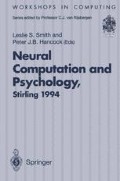Abstract
As an appropriate topic for a workshop on Neural Computation and Psychology, I discuss the relationships that can be established between conventional, symbolic (“rule-based”) and subsymbolic approaches to cognition. I first make some general remarks about symbolic and non-symbolic approaches. I then describe a framework, due to Foster (1992), within which different methods for solving the same computational problem can be compared. I then demonstrate the use of this framework as applied to a specific example. I use this illustrative example to consider whether subsymbolic methods are merely implementations of symbolic ones.
Access this chapter
Tax calculation will be finalised at checkout
Purchases are for personal use only
Preview
Unable to display preview. Download preview PDF.
References
Chater, N., & Oaksford, M. (1990). Autonomy, implementation and cognitive architecture: A reply to Fodor and Pylyshyn. Cognition, 34, 93–107.
Churchland, P. S., & Sejnowski, T. J. (1992). The Computational Brain. MIT Press/Bradford Books, Cambridge, MA.
Clark, A. (1989). Microcognition: Philosophy, Cognitive Science and Parallel Distributed Processing. MIT Press/Bradford Books, Cambridge, MA.
Dennett, D. C. (1971). Intentional systems. The Journal of Philosophy, 68, 87–106.
Fodor, J. A. (1975). The Language of Thought. Crowell, New York.
Fodor, J. A., & Pylyshyn, Z. W. (1988). Connectionism and cognitive architecture: A critical analysis. Cognition, 28, 3–71.
Forrest, J. H. (1987). Computations in PDP networks. Master’s thesis, University of Edinburgh.
Foster, C. L. (1992). Algorithms, Abstraction and Implementation. Academic Press, London.
Haugeland, J. (1985). Artificial Intelligence: The Very Idea. MIT Press/Bradford Books, Cambridge, MA.
Hofstadter, D. R. (1980). Godei, Escher, Bach: an Eternal Golden Braid. Penguin Books.
Marr, D. (1982). Vision. Freeman, San Francisco.
Newell, A. (1982). The knowledge level. Artificial Intelligence, 18, 87–127.
Newell, A., & Simon, H. (1981). Computer science as empirical inquiry. In Haugeland, J. (Ed.), Mind Design. Bradford Books, Montgomery, VT.
Pylyshyn, Z. W. (1984). Computation and Cognition. MIT Press, Cambridge, MA.
Rumelhart, D. E., Hinton, G. E., & Williams, R. J. (1986). Learning representations by back-propagating errors. Nature, 323, 533–536.
Rumelhart, D. E., & McClelland, J. L. (1985). Levels indeed! A response to Broadbent. Journal of Experimental Psychology: General, 114, 193–197.
Smolensky, P. (1987). The constituent structure of connectionist mental states: A reply to Fodor and Pylyshyn. The Southern Journal of Philosophy, 26, 137–159.
Smolensky, P. (1988). On the proper treatment of connectionism. Behavioural and Brain Sciences, 11, 1–74.
Willshaw, D. J. (1994). Sub-symbolic and non-symbolic models. Phil Trans Roy Soc A, in press.
Author information
Authors and Affiliations
Editor information
Editors and Affiliations
Rights and permissions
Copyright information
© 1995 Springer-Verlag London
About this paper
Cite this paper
Willshaw, D. (1995). Symbolic and Subsymbolic Approaches to Cognition. In: Smith, L.S., Hancock, P.J.B. (eds) Neural Computation and Psychology. Workshops in Computing. Springer, London. https://doi.org/10.1007/978-1-4471-3579-1_1
Download citation
DOI: https://doi.org/10.1007/978-1-4471-3579-1_1
Publisher Name: Springer, London
Print ISBN: 978-3-540-19948-9
Online ISBN: 978-1-4471-3579-1
eBook Packages: Springer Book Archive

